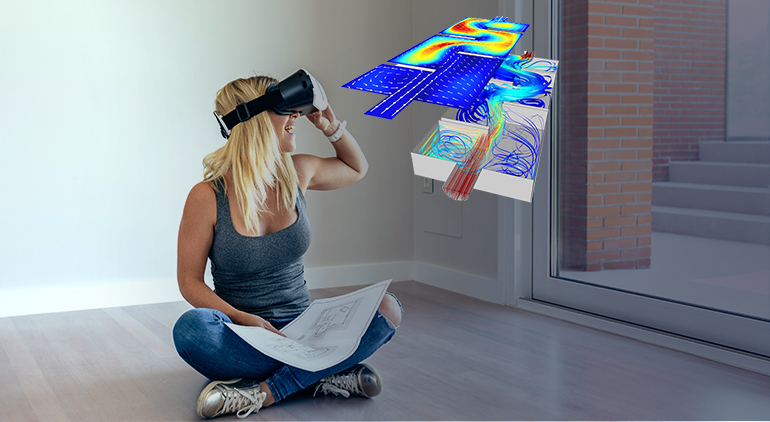VR for Understanding Fluid Mechanics and Centrifugal Pump

After 2020, the virtual reality market is becoming increasingly prominent. VR has the potential to become an efficient design and productive vehicle for the delivery of CFD education. This is evident from the domination of VR in the higher education sector.
From $656.6 Million in 2018, the global virtual reality education market is expected to reach $13,098.2 Million by 2026.
The CAGR exhibited by the market from 2018 to 2026 will be 42.9%.
It was mentioned earlier that VR can become an efficient delivery vehicle of CFD and fluid dynamics education. Let us take a look at how VR will be beneficial.
But first, let us see the challenges faced by the current model of education delivery.
Challenges of Traditional Fluid Mechanics Education
Institutions succumb to the usage of traditional delivery of education including rote learning and bookish tutoring. Though these methods are effective, it does not represent a real-life scenario.
It is also limited by the number of machines accessible to the institution. It also lacks the integration of hazardous scenarios or familiarizing with high-risk situations.
For instance, a student may be well versed in the underlying formulas and the base theories.
The student will also have seen graphical or illustrative and diagrammatic pieces of the working of fluid mechanics. However, a cross-sectional view is lacking.
The student may know about the causes and effects of pressure difference but is not able to identify the subtle intricacies of how pressure difference arises within a machine.
This includes variables like the materials, the positioning, the shape, and other dynamic influences.
Through 3D visualization, these subtleties become much clearer. VR aims at bringing the industrial applications and the curriculum objectives under a single umbrella.
An immersive umbrella. It allows students to apply different principles of fluid mechanics in a real-life, simulated situation and analyze the outcomes in a safe environment.
Let us now take a look at the benefits.
"Gear Up for an Exciting Fluid Dynamics Adventure: Immerse Yourself in Virtual Reality Education Today!"
Benefits of Using VR for Fluid Mechanics Education
The academic content is currently defined by modules like VR fluid statics, VR fluid kinematics, Bernoulli equation, momentum, dimensional analysis, internal flow, differential analysis, compressible flow, and open channel flow among others.
By visualizing flow fields, VR environments can make the patterns visible to the learner. This can be especially beneficial in understanding the optimization of propulsion of nautical vehicles.
The depth and size distortion that occurs in a traditional environment can be done away with, allowing the students to interact with the visualized data in a more natural manner.
The immersion becomes much more fascinating when the interface allows the students to switch between time, orientation, and positions using the haptic devices.
Now that the benefits have been laid out, let us take a look at one particular use case.
Related post: Future Virtual Industrial Visits For Engineering Students
 Get the App from Meta Store: Download Now
Get the App from Meta Store: Download Now
VR for Understanding Centrifugal Pump
Centrifugal pumps create centrifugal force by rotating an impeller that transfers energy to the liquid.” This concept of pumping principles can be demonstrated in an interesting manner through VR environments. The benefits include:
Demonstrating the rotation of the impeller can be made interactive through VR.
The added advantage lies in giving the student the ability to dismantle the entire pump and watch the rotation. This enhances engagement with the learning module.
The motor, shaft, casing, eye of the impeller, and volute can be interacted with.
The creation of low velocity at the eye and the increase in liquid velocity can be experienced by the learner.
Such detailed illustrations along with the ability to interact with it in a natural manner increase retention as well as interest in the subject.
The industrial applications of fluid VR mechanics when it comes to higher education are plenty. This includes hydropower, water pumps, turbomachinery, hydraulic actuators, and aircraft design among a plethora of others.
VR in engineering education creates a safe playground for the student to experiment with these applications. The benefits are plenty and the adoption is undergoing aggressive expansion throughout the education sector. What can we conclude from this?
Conclusion
Through the evolution of digital data, increasing processing power, and enhanced algorithmic efficiency, the discipline of computational fluid VR mechanics had emerged.
This is the current standard of fluid dynamic simulation and understanding. The computational fluid mechanics market exhibited a value of $1930 Million in 2020.
Now VR is here to create a new norm for the same educational principle through a better channel of content delivery. At iXR Labs, we have a plethora of virtual machines and simulated labs designed to perfection following the industrial norms.
Check out www.ixrlabs.com to understand more about our tech.
.png)
.png)



